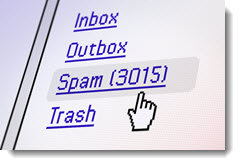Over at marketing automation firm Marketo, CEO Phil Fernandez just wrote a full-throated rant against the evils of unsolicited email and purchased email lists used indiscriminately:
 “How does anyone think that these are sensible emails to send to the CEO of a fast-growing public company? Do they really think that I’m going to spend my Tuesday morning getting signed up for some cheap BI training, order up a website review, and do a deep dive on our corporate telephone system?”
“How does anyone think that these are sensible emails to send to the CEO of a fast-growing public company? Do they really think that I’m going to spend my Tuesday morning getting signed up for some cheap BI training, order up a website review, and do a deep dive on our corporate telephone system?”
I’m guessing the answer to these questions, in Phil’s case, is a big fat “no.” In fact, he concludes:
“Stop sending batch email blasts. Stop buying lists. Use email only to contact your customers when you have something specific to say to them, and explicit permission to talk to them. This is the only way that email is going to survive as a useful tool for any of us.”
Now, I hate spam as much as the next guy (though possibly slightly less than Phil.) I’ll even agree that any type of “spray and pray” advertising – the type that makes no attempt to target the right audience, deliver relevant content, or offer information of value, should be frowned upon if not outlawed completely.
But that’s different from saying (as my Marketo friend would have it) that email should never be used for any situation other than a) to an existing customer and b) any other contact from whom you’ve received explicit permission.
Look, I’m a huge proponent of using email as a vehicle to nurture both existing prospects (people who have engaged with your company and/or otherwise “raised their hand”) and existing customers. And marketing automation – the technology that empowers more personal, timely, relevant emails – just may be the best thing to happen to marketing since the Sears Catalog. (Full disclaimer: my firm, Spear Marketing Group, is a leading Marketo partner.)
But even then, I’d argue that emailing to a “cold” list still has a place in the arsenal of today’s B2B Marketer. It just needs to be used intelligently, sparingly, and strategically.
In my day-to-day work, I run into many clients whose salespeople purchase email lists en masse from the likes of Data.com and upload them into their CRM system. Because salespeople, by nature, will always aim for the highest level of purchase authority to which they have access, those lists often include C-level executives who – take Mr. Fernandez as an example – will never respond. If those purchased lists, as is often the case, filter into the company’s demand generation engine, the result is the kind of indiscriminate, untargeted campaigns that are the topic of Phil’s rant.
But let’s say your sales team wants to go after 200 “target accounts” within the financial services industry. I see no crime in acquiring the names (and email addresses) from a reputable source of relevant decision-makers within those accounts, and sending a series of well-crafted, informational, relevant emails to those same executives.
I’m old enough to remember when list-based marketing was the workhorse of B2B demand generation (or, as we called it back then, “direct marketing.”) Those days are long gone. Today’s modern demand generation is driven by content marketing, social media, search marketing, and other inbound strategies. Email, and even direct mail, is primarily used for lead nurturing, not lead acquisition. And that’s all how it should be. However, as I wrote in a recent post, inbound marketing isn’t always an option. In those select situations, list buys still have their place.

very insightful
Recipients can’t be faulted for their frustration. I am also receiving too many unsolicited B2B messages, asking me to respond on topics ranging from website optimization to purchasing bus-stop media to buying lead lists (the latter being, ironically, the very cause of my headaches). And when I don’t reply, invariably many of these result in a “Following up” message where the sender complains “I haven’t heard from you yet on my exciting offer.” With all of the stresses of the workplace and the overwhelming number of messages we all get, firms need to take the time to truly target their messages. And even if they’re personally written to me, some vendors assume I’m willing to spend time researching the right people to contact, and to hand this information over to them. My IT department asks us to forward spam to them so that they can block it across the whole company (thousands of employees). That seems like a nuclear solution, but I won’t hesitate to use it for the worst offenders.